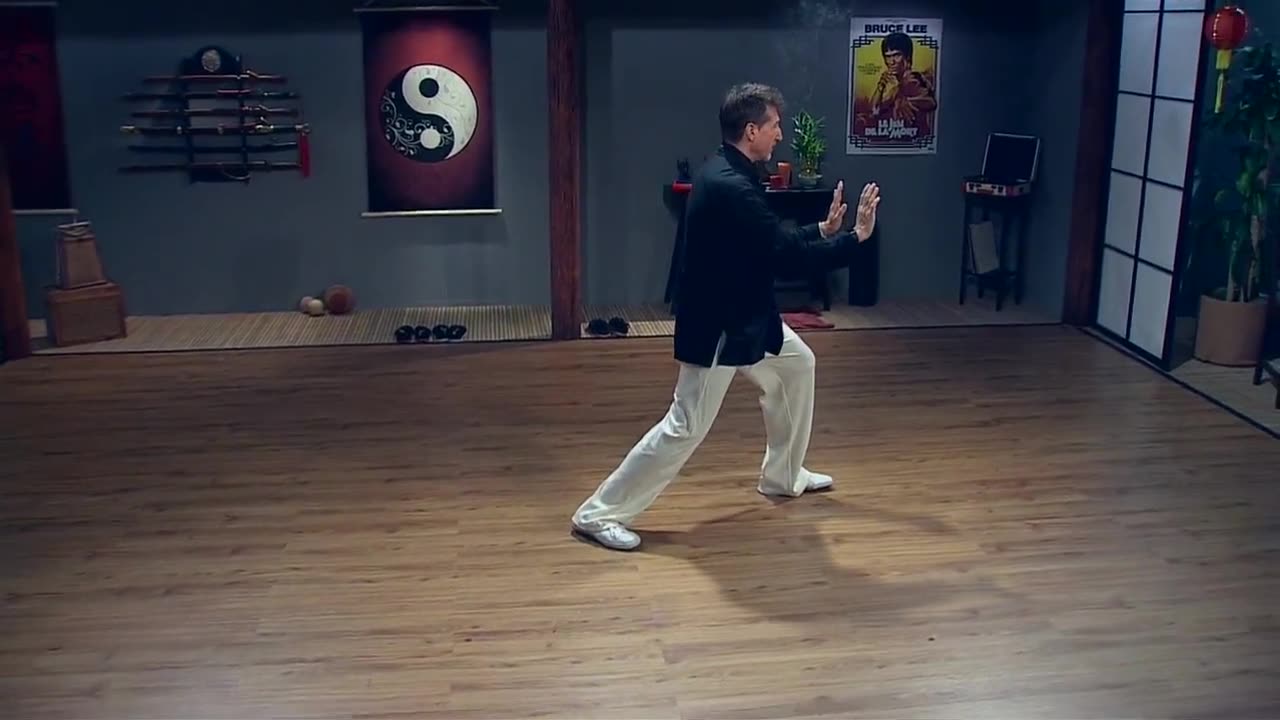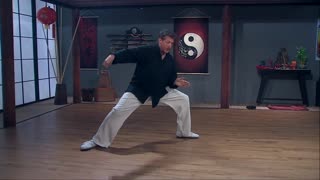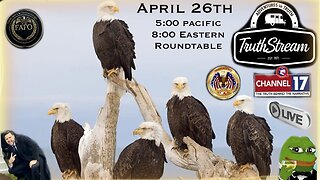Premium Only Content

06. The Bow And Arrow
You’ve no doubt heard the saying “where there’s a will, there’s a way.”
The ancient masters of tai chi probably coined that phrase. The
principles of tai chi imagine that all things are possible if the will is strong.
Unfortunately, the will is like a muscle, and if not exercised continuously, it
will atrophy. Many forms of martial arts train the body and develop speed
and strength in order to defeat an opponent. But what if your opponent
is yourself, your long-rehearsed yet unconscious habits of perception,
thought, point of view, and behavior? No amount of muscular strength will
avail you in that struggle. Only the willpower can stand up to that challenge.
Rú fēng shì bì (“Sealing and Closing”)
● In this lesson, the next movement we’ll learn is called rú fēng shì
bì, which in English means “sealing and closing.”
● While still in the final position of chop downward, parry, and punch,
rotate the left forearm outward, turning the palm up and crossing
the wrist under the right forearm. Simultaneously, rotate the right
forearm out slightly to turn the right palm up. Separate the two
arms by a shoulder width.
● Shift the weight to the rear leg and foot. As you do so, rotate both
forearms inward until the palms face each other and sink both
elbows.
● Shift forward to the left leading bow step and extend the elbows
slightly, rotating both forearms inward so that the palms face east,
and push.
Xié fēi shì (“Diagonal Flying Posture”)
● The next move is xié fēi shì, meaning “diagonal flying posture” or
“slanted flying posture.” To begin, sit back, emptying the weight
out of the left foot and shifting the weight entirely onto the right
foot. Turn the waist to the right and pivot on the left heel, turning
the toe in 90 degrees.
● Separate the right hand away from the left as you turn the waist
to the right until the palm extends to the southwest corner.
Note that the left hand will come with you and now faces the
southeast corner.
● Now, shift the weight back onto the left foot and circle both arms
around to form a hold-the-ball position, left hand on top. Step the
right foot steeply into the northwest corner (65 degrees) to form
a bow step. Simultaneously, chop diagonally upward with the
right hand, ending when the right hand (palm obliquely upward) is
shoulder high. The left hand withdraws downward to the hip, palm
down, fingertips pointing forward.
Willpower and the Bow and Arrow
● In the last couple of lectures, we brought up intention. But what
is intention, how does it operate, and how do you get it to work
for you? The two step process is much like what we call a bow
and arrow.
● Imagine an archer holding the bow, drawing the string back and
releasing the arrow. The intention is like the archer who draws the
bow and releases the arrow, but first the archer has to find the
arrow and what that arrow is. The arrow is known as the shin; it’s
the idea, the concept, the desire, or the picture. Shin can translate
to “heart mind.”
● The heart mind is like crafting or choosing your arrow. A weak
or evil desire is a crooked arrow, but a strong or noble desire is
a straight and true arrow. The tai chi master is like the archer
who never misses his target. He creates the idea, the intention,the picture, the concept, or the desired outcome. Then he sends
it into the bow, draws back the string, and releases all in one
smooth movement.
● Our minds have prejudices, thoughts, confusions, desires, and
impulses. How do we control those? In tai chi, we have the concept
of accumulating merit and virtue. As you become a more virtuous
person, you become the kind of person that can just think and then
see your actions create the outcome you want. Examples of good
outcomes: healthy relationships, or good health for your family, or
prosperity for your community.
● To get to that kind of virtue, you have to perform meritorious
actions. The meritorious actions are themselves very difficult
to be consistent with. It’s so easy to go with bad habits—to
follow the monkey mind. It’s much more difficult to get past
instant gratification and familiarity with action and disconnection
from feeling.
● It’s difficult to perform this work while participating in real
communication or allowing yourself to be vulnerable in
relationships, but those are the kinds of actions that build up
character. Those are the kind of meritorious things that we do that
increase our martial virtue.
● Focused intention is the power of the tai chi master. When you
follow the path of mastering tai chi, you’re following the path that
brings you to a clear vision. The vision translates into the intention
like an arrow the bow pulls back and releases.
-
 30:35
30:35
Mastering Tai Chi
1 year ago21. Five Stages Of Mastery
206 -
 2:37:49
2:37:49
The Connect: With Johnny Mitchell
23 hours ago $2.63 earnedBlackwater Mercenary EXPOSES Private Military War Secrets From The Middle East, Fueling Terrorism
14.1K6 -
 2:54:21
2:54:21
Total Horse Channel
1 day ago2025 Scottsdale Arabian Horse Show | Saturday Evening Session
34.7K3 -
 22:39
22:39
The Mel K Show
5 hours agoMel K & Representative Brandon Gill | Our Constitutional Republic is Being Restored | 4-26-25
34K19 -
 4:17:17
4:17:17
VapinGamers
4 hours ago $0.88 earned📣 Fortnite Family Night! - Games and Dubs with BrianZGame - !rumbot
15.5K1 -
 LIVE
LIVE
ThePope_Live
3 hours agoLIVE - First time playing The Finals in over a YEAR! Still good? with @Arrowthorn
147 watching -
 3:06:26
3:06:26
TruthStream with Joe and Scott
9 hours agoRoundtable with Patriot Underground and News Treason Live 4/26 5pm pacific 8pm Eastern
23.4K19 -
 8:52
8:52
Tundra Tactical
6 hours ago $8.01 earnedSCOTUS Denies Appeal, Minnesota Courts Deal 2a Win!
32.2K8 -
 LIVE
LIVE
a12cat34dog
8 hours agoONE WITH THE DARK & SHADOWS :: The Elder Scrolls IV: Oblivion Remastered :: FIRST-TIME PLAYING {18+}
640 watching -
 22:27
22:27
Exploring With Nug
15 hours ago $12.03 earnedSwamp Yields a Chilling Discovery in 40-Year Search for Missing Man!
46.9K17